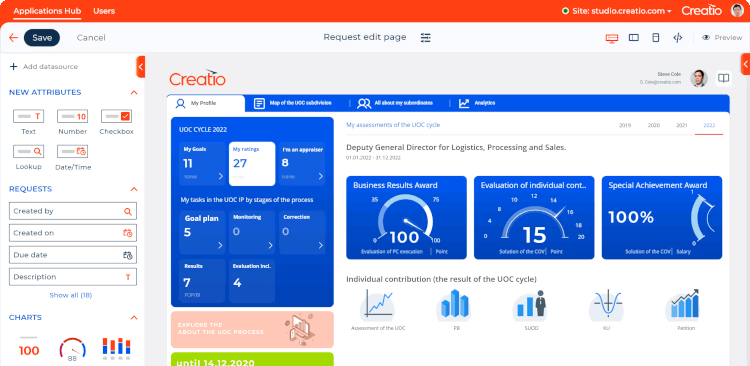Simplify Open System Database Creation with No-Code Growth Operatings Systems
Simplify Open System Database Creation with No-Code Growth Operatings Systems
Blog Article
Discover Just How Scalable Databases Can Be Used Without Coding to Boost Your Organization Workflow
In today's hectic service atmosphere, the capacity to handle and evaluate data efficiently is extremely important. no-code. Scalable databases, especially when paired with no-code remedies, offer a transformative strategy that empowers non-technical customers to simplify procedures.
Understanding Scalable Databases
Scalable data sources are essential for modern service procedures, allowing companies to effectively take care of enhancing quantities of information without compromising performance. These databases are created to grow and adjust to the changing demands of a business, making sure that they can handle larger datasets and even more complicated questions as organizational demands advance.
Understanding scalable databases includes identifying their 2 key kinds: vertical scaling and horizontal scaling. Vertical scaling, or "scaling up," includes including more power (CPU, RAM) to an existing server to improve performance. On the other hand, straight scaling, or "scaling out," requires adding more servers to distribute the load, which often results in higher versatility and mistake resistance.
Another crucial aspect is the style of scalable data sources, which can be either non-relational or relational. Relational databases, such as MySQL and PostgreSQL, are structured and utilize SQL for inquiries, while non-relational data sources, like MongoDB and Cassandra, use even more adaptability with disorganized data.
Eventually, recognizing scalable databases is vital for companies intending to utilize data as a critical possession, allowing them to continue to be competitive in an increasingly data-driven atmosphere.

Advantages of No-Code Solutions
Unlocking the potential of no-code services empowers businesses to streamline operations and enhance efficiency without the demand for substantial shows understanding. These systems permit non-technical individuals to produce, customize, and manage databases effortlessly, therefore democratizing accessibility to innovation across teams.
One of the primary benefits of no-code solutions is their speed of implementation. Organizations can rapidly release applications and automate processes, considerably reducing the moment spent on advancement cycles. This dexterity allows companies to react immediately to market adjustments and customer demands, cultivating an one-upmanship.
Furthermore, no-code systems lower dependence on IT departments for day-to-day tasks, allowing technical teams to focus on even more intricate jobs that need specialized abilities. This change not only maximizes resource allotment but additionally advertises development within the organization.
Cost-effectiveness is one more advantage, as no-code remedies can lower development and maintenance costs. By lessening the demand for coding competence, companies can harness the capabilities of their existing labor force without the expenses of working with added personnel.
Popular No-Code Database Devices
The surge of no-code solutions has actually caused the development of different database devices that provide to organizations looking for efficiency and access. These devices encourage individuals with minimal technical competence to produce, manage, and control databases flawlessly.

Caspio attracts attention for its ability to construct web applications with no coding. It enables businesses to produce robust databases and release applications rapidly, dealing with various market needs. Propensity offers powerful information and user-friendly user interfaces monitoring abilities, allowing companies to develop customized applications tailored to their workflows.

Usage Cases in Organization Operations
Exactly how can services leverage database devices to boost their operations? Scalable data sources supply companies with effective abilities to take care of and assess data without the demand for comprehensive coding expertise. These devices can simplify various organization procedures, eventually bring about enhanced performance and efficiency.
One prominent use situation is client relationship administration (CRM) Companies can use scalable data sources to track consumer interactions, choices, and responses, enabling personalized communication and much better service. By streamlining this info, teams can work together better and reply to customer needs in real-time.
One more substantial application is inventory management. Firms can use no-code data source devices to keep an eye on stock levels, track deliveries, and forecast demand. This ensures optimal stock degrees, decreases waste, and minimizes stockouts.
In addition, project administration can gain from scalable data sources by enabling teams to take care of tasks, deadlines, and resources in a linked platform. With real-time updates and information visualization, project managers can make educated decisions.
Getting Going With Implementation
Implementing scalable databases in organization operations requires an organized approach to make sure successful combination and usage. The initial step is to carry out an extensive demands analysis, recognizing particular service needs, data types, and expected development patterns. This find this fundamental understanding will direct the option of the ideal database option.
Following, pick an user-friendly, no-code data source platform that aligns with your operational objectives. no-code. Many contemporary solutions offer user-friendly user interfaces, permitting non-technical customers to manage information properly. After selecting a he said platform, develop a clear data design that outlines exactly how information will be arranged, accessed, and preserved
Training is important; make certain that employee are geared up with the necessary skills to utilize the database. Think about providing workshops or tutorials to familiarize personnel with the system's functionalities.
Final Thought
In final thought, the combination of scalable data sources through no-code options provides substantial benefits for business operations. These platforms empower non-technical customers to efficiently handle and evaluate data, facilitating improved decision-making and collaboration. By embracing devices such as Airtable and Idea, companies can minimize and improve processes reliance on IT sources. Ultimately, leveraging these modern technologies can bring about improved performance and operational effectiveness, positioning companies for continual development in an affordable landscape.
One preferred no-code database tool is Airtable, which integrates the performance of a spreadsheet with the power of a data source.How can organizations take advantage of database devices to enhance their operations? Companies can make use of scalable databases to track client interactions, preferences, and comments, making it possible for individualized interaction and better service.Implementing scalable databases in organization operations needs a structured strategy to make certain effective combination and usage.In verdict, the combination of scalable databases via no-code remedies offers significant advantages for company procedures.
Report this page